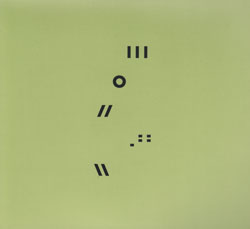
Many will think of Christian Wolff as the protégé of John Cage, the sixteen-year old sponge (to Cage's thirty-eight years) who turned up at the composer's door for lessons at the behest of a mutual friend / Wolff's piano teacher (Varèse was a family acquaintance and suggested mentor, but Wolff wanted more questions than answers). Under the influence of Cage and an assignment to aid in the transcription of a Webern piece, Wolff began to abandon his dense cannons in favor of brief, compressed four and five note gestures; in Cage's circle, Wolff would also meet Morton Feldman and David Tudor. But it was Wolff who, with parents as literary publishers, brought Cage his first shiny copy of the I Ching. This fortunate back-and-forth musical relationship fostered not only Wolff's realization as a composer but the prosiliency of the New York School.
Throughout this double-disc collection, the listener can hear the evolution of Wolff from pupil (For Prepared Piano, 1951) to graduate (For 1, 2, Or 3 People, 1964) to teacher (his Prose Collection of the late 1960s). Though his work would continue to be rooted in amoebic particulates, he learned to organize the disorganized but keep the events...naturally scattered; his music retains the element of surprise and internal independence, and we witness two-decades-worth of Wolff discovering how to point elements in a collected, interesting direction — the way the tide can regulate shells and rocks and sand on a beach into an "arrangement", or how wind guides a selected set of chimes into "patterns".
And Wolff's choice of performers arguably enhanced the musical realizations of his sparse graphical scores (though Wolff's aesthetic welcomes "non-musicians...people with an interest in music", he certainly set a precedent with those he chose to appear on his albums). On Duo for Violinist and Pianist (this recording from 1973), János Négyesy and Cornelius Cardew take visual cues from one another, flipping between extended silences and sharp elision; longtime collaborators Frederic Rzewski and David Tudor offer their creative intelligence to two different versions each of For Piano I (1952, 1956) and For Pianist (both recorded in 1959); late 1960s "electronic music group" Gentle Fire (Richard Bernas, Stockhausen assistant / understated instrument inventor Hugh Davies, Graham Hearn, Stuart Jones, Michael Robinson) apply myriad amplified strings and thumps, growls, churning atmospherics and otherwise electroacoustics to the 1968 Edges (version 1974); Hamburg sound art collective Nelly Boyd finds inspiration in Wolff's text "Make sounds with stones, draw sounds out of stones, using a number of sizes and kinds..." on Stones (recorded in 1998). The closer, Drinks (1969), is a wild, mute dinner party (carried out by Arbeitsgemeinschaft für Neue Musik) that expresses itself with gurgles, clinking cups, pouring drinks and intermittent ringing goblets.
Kompositionen 1950-1972 is a captivating document of a naïve high school kid with the determination and growing talent to move from nothing, to spending every lunch hour at Cage's piano, to a figure associated with and influence on the most important time in 20th Century and beyond music.
Comments and Feedback:



More Recent Reviews, Articles, and Interviews @ The Squid's Ear...


|

